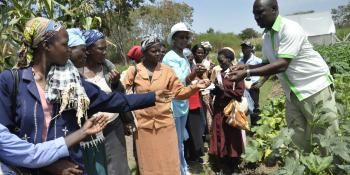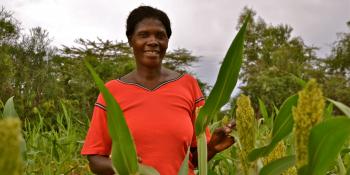Kenya is located in East Africa with a land area of 580,728km2, of which approximately 85% is arid and semi-arid land. According to the 2009 census, the country had a total population of 39 million people, with about 68% of the population living in rural areas. The country’s annual gross domestic product (GDP) is estimated to be around USD 60.94 billion (Worldbank, 2014).
Agriculture is the largest contributor to Kenya’s GDP, directly contributing about 25.4% of the GDP and indirectly contributing another 27% via linkages to agro-based industries and the service sector. The agriculture sector is comprised of crops, livestock and fisheries subsectors. Key challenges for the agriculture sector include over-reliance on rain-fed agriculture, low adoption of modern technology, and biotic and abiotic stresses such as pests, diseases, droughts and floods which lead to yield losses for crops and livestock. Other challenges include limited access to affordable credit for purchasing farm inputs, as well as poor marketing infrastructure for produce.
In order to build resilience in agricultural systems within Kenya, the CGIAR Research Program on Climate Change, Agriculture and Food Security (CCAFS) promotes innovations by tapping into the expertise of other CGIAR Centers, as well as other national and regional research networks. Efforts are focused around the promotion of climate-smart agriculture that faciliates adaptation in cereal-based and livestock systems. In addition, CCAFS works with the Ministry of Agriculture, Livestock and Fisheries (MALF) and the Ministry of Environment and Natural Resources (MENR) to mainstream climate change into national agriculture plans and agriculture into climate change policy.
Key initiatives in Kenya:
Climate-smart villages (CSVs): These are models of local actions that ensure food security, promote adaptation and build resilience to climatic stresses. In the CSVs, researchers, local partners, farmers’ groups and policymakers test portfolios of climate-smart agriculture (CSA) technologies and practices with the aim of scaling up successful innovations. In Kenya, the CSVs are located in Nyando in Western Kenya and Makueni in Eastern Kenya. Ongoing participatory action research in the CSVs includes testing of drought tolerant crop varieties and improving productivity of small ruminants (sheep and goats) through establishment of sustainable breeding programs. Read more: Scaling up climate-smart village models in East Africa. Early results from the Nyando CSV activities: Climate-smart villages and the hope of food secure households.
Decision support tools: Climate scenarios and climate analogues help to improve local and national adaptation planning by identifying target technology and development domains. CCAFS has helped a range of stakeholders across Kenya to harness these methods through specialised training and capacity building sessions. Through the Farms of the Future project, farmers froms Nyando embarked on a journey to analogue sites where they learnt about practices and technologies that might strengthen their capacity to adapt to the future climate of Nyando.
Partnerships for climate resilient systems: In collaboration with MALF and MENR, the program is piloting and rolling out CSA technologies and practices identified in the National Adaptation Plan and National Climate Change Action Plan. Read more: partnerships for climate resilient agriculture and food systems.


